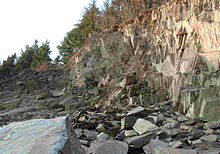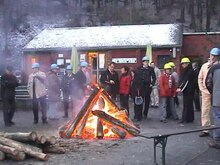Fell visitor mine
The Fell Exhibition Mine is as a visitor mine decorated former slate - mining in the former slate quarries Barbara and hope in the former fur - Thommer mining site Nossernbachtal , about 20 kilometers east of Trier . There is an information center with a mining museum next to the entrance to the mine. A mine hiking trail opens up a further twelve tunnel entrances and the former Vogelsberg quarry . On the other side of the valley, the former Thommerberg quarry and a Bremsberg can be visited. The program of the visitor mine includes cultural events in front of the entrance and in the mine itself, the facility is located directly on the Schiefer-Wackenweg .
The show mine
The visitor mine consists of two typical roof slate pits (mines) from the turn of the 19th and 20th centuries. The upper Hope tunnel has been documented since 1850, the lower Barbara tunnel since 1908. The two mines are connected by a 100 meter long stairwell.
The underground tour takes a good hour and goes through long tunnels and stretches and through several extraction chambers . Miner figures in the extraction chambers document the dangerous work of pre-industrial slate mining. There, visitors get a vivid impression of the hard work in slate mining from the Middle Ages to the 20th century. In the extraction chambers, visitors can see the mighty rubble heaps (“Prass”), the so-called mountain walls , and the extraction sites for the blue-gray roofing slate.
The slate was mined underground by “ cutting ” and “wedging” or by drilling and “ shooting ” (blasting) and initially conveyed the surface in blocks as large as possible. Over the course of days, the large blocks were broken up into small blocks ("beheaded"), which were then split into thin plates with the cleavage iron. The slabs were then finally cut into the correct shape (“trimmed”) with slate shears or with the “two-pointed hammer” and came on the market as roofing slate (the coveted “blue Leien”). In the winter months, the slate miners saw no daylight for months. This is why an artificial "sun" rises in an imposing extraction chamber 70 meters below ground in the Fell visitor mine.
On September 20, 1991, the Förderverein visitors mine Fell e. V. was founded and in 1994 the municipality of Fell started expansion . The visitor mine operated by the municipality of Fell opened on May 1, 1997 and was visited by more than 300,000 visitors by 2016.
The information center / mining museum
The newly built information center / museum, opened in 2013, is located in front of the Fell visitor mine. It was designed to be interactive and can be viewed without barriers. The visitors can immerse themselves individually in the topics geology (formation of the slate), slate mining in the past / today, the life of the 16 different bat species in the region and the viticulture. Here you can find u. a. rare and strange devices from slate mining and viticulture, it is u. a. the following “ tack ” (miner's tools) on display: pickaxes and wedge- shaped chisels, split iron and roofing slate templates, head wedges and various slate hammers and shears. There are also protective helmets (“hats”), mining “ lights ” (pit lamps), blasting machines and heavy drilling equipment (jackhammers). Furthermore, tools from the roofing are ( Haubrücken , roofing hammers, nail puller u. A.) And (u Hotten, Vineyard knife Gärt judge vineyard spraying. A.) The domestic viticulture issued and see 12 different cladding types of roofing.
A video shows the most modern slate mining in Central Europe in Katzenberg near Mayen in the Eifel . The statue of Saint Barbara from 1897 occupies a special place in the museum . St. Barbara is the patron saint of miners. 22 different mining vehicles (including from Luxembourg, France and Belgium) document the track-based mining in various mining branches. The trolley exhibition and the information center / museum are freely accessible during the opening hours of the visitor mine.
The mine hiking trail
The Grubenwanderweg is an educational trail about slate mining and leads through the Nossern Valley, past the relics of the former roof slate mining: terraced heaps , old mine wagons , desert trails that used to be used to transport slate, tunnel mouth holes that bear witness to the former mining and past portraits of the saints Barbara , who was venerated by the miners as an emergency helper and patron saint.
There are ten slate-covered information stands in front of the tunnel mouth holes. The slate coverings are designed in various types of cover. Based on the pit picture (= ground plan of the mine) on the green information boards, you can get an idea of the size and complexity of the tunnel system.
Culture and customs
The most important bearers of the mining tradition in the former mining towns of Fell and Thomm are the Fell miner's chapel , which was founded in 1955 and whose predecessor chapels can be traced back to 1871, and the Glück-Auf Thomm 1927 e. V.
Every year on the second Sunday in Advent (the Sunday after Saint Barbara's name day, December 4th), the traditional parade of the miners 'chapel, known as the miners' parade , takes place in Fell and Thomm . Every two years before Christmas, a mettenschicht is celebrated.
In summer, cultural events take place in front of the mine entrance at irregular intervals. A highlight were the celebrations for the tenth anniversary of the visitor mine on the 14th and 15th. July 2007 with several concerts and a big mountain parade.
When the weather is good, the Feller hunting horn players often play on Sunday mornings in front of the mine.
Web links
Coordinates: 49 ° 45 ′ 21.2 " N , 6 ° 47 ′ 56.7" E







